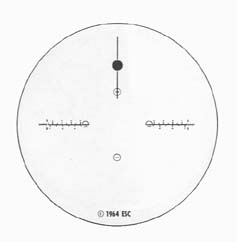THE SUN DISC (D) AND HOW TO READ IT
The sun's position in the sky is shown continuously by the position of the gold circular sun. It is visible to you when it appears within the light blue horizon ellipse on fixed Horizon and Hour Disc (B). The gold line drawn through it points to "south'' (which is at the gold numeral 12) at the top of the fixed Disc (B), when the sun is at ''high noon'', or at meridian.
The gold line extending through the sun also points to the day and month on Star and Calendar Disc (E), and to the 24-hour solar time dial marked in gold numerals on fixed Horizon and Hour Disc (B). Two gold scales, opposite one another and graduated in half-hours, show time of sunrise and sunset when read against the gold circular shape on Disc (E).
This Sun Disc also carries the phases of the moon.

Setting the Sun Disc
Solar time is generally somewhat different from standard or daylight time. To set the sun disc requires:
STEP 1
You first need to know standard time. If you have set the regular clock dial
(lower left) for daylight saving time, deduct 1 hour from this figure.
STEP 2
You now need to know local mean time for the exact meridian (longitude) where you live. On pages 28 and 29 are charts to help you find this. In the U.S.A. there are four time meridians which are ''standard'' occurring at exactly 75 degrees, 90 degrees, 105 degrees and 120 degrees longitude. The sun travels across the U.S.A. from East to West, and it is most important to remember that wherever the sun is at its zenith, at that location it is 12 noon, solar time (see illustration No. 2, page 26). Therefore, for a sun position east of a standard time meridian it is locally high noon while the standard time (for the standard meridian as well as for the whole standard zone) is still before noon. For each 1 degree of longitude your location is east of a standard time meridian, add 4 minutes (1/4 of a degree=1 minute) to the standard time to compute solar (local mean time). For each 10 your location is west of a standard time meridian, deduct 4 minutes from standard time.
STEP 3
Sun Disc D is read against the gold 24-hour scale. If you are setting the Sun Disc for the a.m., use the answer obtained from step 2 directly. In the p.m. hours, add 12 hours to the local solar time as calculated in Step 2. This is the figure you need for setting Disc D.
EXAMPLE
1. Assume your local daylight saving time is 3:00 p.m.
2. Deduct 1 hour to obtain standard time. -1:00
3. This is your local standard time. 2:00
4. Assume you live in New York City which is located on longitude 74 degrees. The nearest time meridian is 75 degrees, so there is a difference of 1 degree between New York City's longitude and that of the time meridian. 75 degrees-74 degrees = 10 degrees.
Since the sun time east of a standard time meridian is later than standard time, by approximately 4 minutes for every 1 degree, 2:00 p.m.
add 4 minutes to standard time, giving +:04
our local sun (solar or mean) time in New York 2:04
City as 2:04 p.m.
5. Your Sun Disc has a 24-hour dial.
To set it for the p.m. add 12 hours +12:00
6. This figure, 14:04 is the exact 14:04
time at which you should set your
Sun Disc D.
USE SPACE BELOW FOR YOUR CALCULATIONS
| 1. Your local time | ||
| 2. If daylight saving time, subtract one hour | -1:00 | |
| 3. Result: Standard time | ||
| 4. Nearest meridian | degrees | |
| 5. Your longitude | degrees | |
| 6. Difference in degrees | degrees | |
| 7. Difference equivalent in minutes of time (1degree=4 min.) | ||
| 8. If east of standard meridian, add line 7 to line 3 | SUM | |
| If west of standard meridian OR Subtract line 7 from line 3 | DIFF | |
| 9. If P.M. time, add 12 hours | +12:00 | |
| 10. Time you should set Disc D (Solar time for your longitude) |
More pictures of Spilhaus Space Clock and how to repair it.
